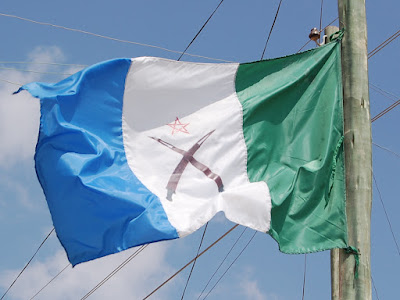Ab-ala, avamposto Afar, Ab-ala avant-poste Afar, Ab-ala Afar outpost
 In vendita qualche metro di corda, fatta a mano, per pochi Birr, cioè per 50 cents di euro.
In vendita qualche metro di corda, fatta a mano, per pochi Birr, cioè per 50 cents di euro.Some meters of hand-made rope for sale, for a few Birr ( 0,50 euro cents)
Les femmes Afar ne portent anneaux et bracelets que sur la main et le bras gauches.
The Afar women wear rings and bracelets only on their left hands and arms.

 Ragazza Afar. Une fille Afar. Afar girl.
Ragazza Afar. Une fille Afar. Afar girl. Un pastore Afar conduce i suoi dromedari per venderli al mercato.
Un pastore Afar conduce i suoi dromedari per venderli al mercato.Un berger Afar conduit ses dromadaires pour les vendre au marché.
An Afar shepherd brings the own dromadary to the market.
Pare che sia vietato agli Afar di frequentare il mercato armati di kalashnikof e ghilé (jilé) e ai Tigrigni senza armi da fuoco i loro bastoni. Infatti il primo giovedì, giorno di mercato, erano tutti "disarmati". Al contrario durante la mia seconda visita erano tutti armati fino ai denti: pistole, mitra, ghilè di tutte le dimensioni (pugnali ricurvi), bastoni, poiché mancava il controllo della Polizia.
Avevo scattato molte foto nella mia precedente visita a donne Afar con le loro collane multicolori. Alcune le ho fatte stampare e alla mia seconda visita ho donato loro le foto. Hanno avuto un successone: desideravano tutte essere fotografate.
Nel mercato erano in vendita coperte nere di grandi dimensioni tessute con lana di pecora. Servono alle donne Afar per fare un "bagno di fumo". Hanno cercato di spiegarmelo ma sinceramente ho capito poco. Pare che accendono, dentro le loro tipiche capanne, un fuoco con un tipo di legna che produce tanto fumo. Ma non soffocano? E i loro occhi come fanno a resistere al fumo? Mi hanno promesso di farmi vedere a Macallé come funziona il "bagno di fumo" che serve per rendere liscia la pelle, tanto in voga tra le donne Afar e presso le donne tigrigne che possono permetterselo in città...
It seems that is forbidden for the Afars to come to the market armed with Kalashnikov and ghilé and for the tigrinians without fire arms and their sticks. In fact, on Thursdays, market-day, they were all "un-armed". But, in the contrary, during my second visit, they were armed to the hilt: pistols, machine-guns, swords and knives of all shapes and sizes, and sticks since there was no plice control.
I had taken several photographs during my previous visit of Afar women with the multicolored necklaces. Some of these I printed and during my second visit I gave them their photographs. It was quite a success: all of them wanted to be photographed.
In the market there were big blacks blankets for sale weaved with sheep yarn. It is used by the women to create a "smoke bath". They tried to explain this, but frankly I did not quite understand. It seems that they light, in their typical huts, a fire with a kind of log that produces a lot of smoke. But, don't they suffocate? And how can their eyes resist? They promised to show me in Macallé how the "smoke bath" works and how it helps keeps the skin smooth and soft-in vogue with the Afar and Tigrinians women.
































